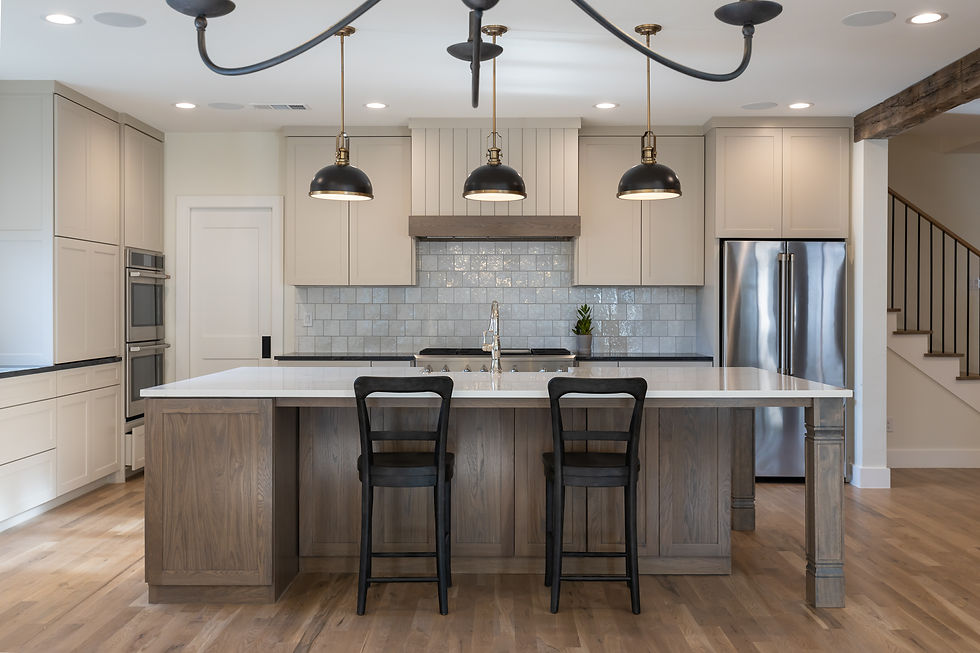On nearly every design project we work on, we get this question:
“Can I mix metal finishes in the same space?”
We’re here to tell you, not only is the answer, YES YOU CAN but also YOU ABSOLUTELY SHOULD.
Wait, what?! We strongly recommend mixing metals in your space for 2 big reasons:
It makes the space feel layered and collected, rather than straight out of a catalog, and
It gives you flexibility over time. If you’ve got more than one metal in the space, then you don’t have to stand in the aisle of Home Goods having an identity crisis on whether you can bring a brass doo-dad into your room without it looking out of place. You’ve got a palette of finishes to play with.
But there is an art to it. There’s a few metals that really do not play well together, and some that look better together than on their own. Let’s break ‘em down!

Here we mixed polished nickel and brass. Both have warm undertones, making them a great match. The plumbing fixtures are polished nickel and the hardware and lighting are brass.
#1 - UNDERSTAND UNDERTONES
Undertones are SO CRITICAL in choosing metal finishes, paint colors, and basically all materials. If you have no idea what I’m talking about, an undertone is a color under the color you’re looking at. Gray is a great example. Have you ever picked out a gray paint and put it up on the wall, and it turns lavender? That means it has a purple undertone. Or it turns greenish? Yep, the green undertone is the culprit. Nearly every material has some sort of undertone that you need to identify.

This is critical because it leads to Rule #1 of mixing metals – when in doubt, keep the same undertones.
Cool undertones and warm undertones often don’t mix well. Stick with the same undertone for a fool proof result.
You can use matte black as a wild card - its undertone is neutral and works with both warm and cool undertones.
Top tip – never, ever, EVER mix chrome and nickel. They are both silver tones, but with different undertones, and they will look awful together.
#2 – MIXING FINISHES
Brushed, satin, polished, hammered, matte – all of that comes into play too. In our book, you can mix these together pretty freely! Polished nickel or chrome look great with matte black. Hammered copper works with satin oil rubbed bronze. Satin antique brass works with polished nickel.
The only thing that we don’t recommend – mixing 2 finishes in the same color. For example, don’t mix polished nickel and brushed nickel – it will look like you tried to make them all match, but missed.
Rule #2 – if your metals are different then you can mix the finishes.

Here we mixed polished chrome and matte black. The plumbing fixtures, mirrors, and cabinet hardware are matte black, and we popped in a bright polished chrome on the light fixture.
#3 – HOW MANY METALS TO MIX
Rule #3 with mixing metals – always 2, but no more than 3 finishes. This will create a layered space that still feels unified and intentional. When you get above 3 metal finishes, you get into the land of Eclectic. If Eclectic is your jam, then roll with it! But if your goal is to create a cohesive, pulled-together space, stick with 2-3.
Here are our favorite combinations!

Tip – we don’t include stainless steel appliances in that count. They can be a 4th metal, like the image below, and still, work because our brains universally accept stainless steel appliances as their own thing.

Here we mixed polished nickel, antique brass, and black. The plumbing fixtures are polished nickel, hardware was brass (it wasn’t installed yet during this progress pic, but they were eventually brass!), and the lighting was brass and black. All have warm undertones which help them work together.
GUIDELINE #4 – HOW TO MIX
Which pieces in your room should get which finishes? Rule #4 is to keep your major categories consistent, and mix it up with accessories.
Keep all of your plumbing fixtures in the same finish.
Keep hardware in the same finish.
Lighting can be mixed between finishes, often because light fixtures themselves might have more than 1 finish on them.
Accessories can play off of any finish in the room and can be in different finishes.
Some examples: your kitchen faucet and pot filler should be the same, and your shower faucet and sink faucet in the bathroom should be the same. Change it up by bringing in a complementary finish in your mirrors, cabinet hardware, and lighting fixtures.
This doesn't have to stay consistent room by room. Your master bath plumbing can all be polished nickel, and your powder room faucet could be brass. Just use the same colors and finishes within your whole house. Again, choosing 2-3 to sprinkle throughout your home.

Here we matte black and brushed gold.
Hopefully this takes some of the mystery and angst out of mixing metals! Follow us on Instagram for more mixing metal inspiration.


Hello Rebecca,
I see your explanation for why polished nickel is preferred over satin nickel in the matte black/any brass/gold/polished nickel combination. What about using brushed nickel instead of polished nickel?
Also do you have any recommendations for any bathtub and shower faucets that offer any type of spot protection? I see Delta offers spotshield but only in brushed nickel.
Also can you explain why it is recommended for your shower faucet and sink faucet in the same bathroom to be the same?
Thank you,
Ana
This is such a great article! One question - You show black & gold and black & nickel as good options. But when mixing the 3 together, you specify black & gold & polished nickel. Any reason to avoid satin nickel in this trio? Thank you for making my upcoming reno decisions SOOO much easier :)